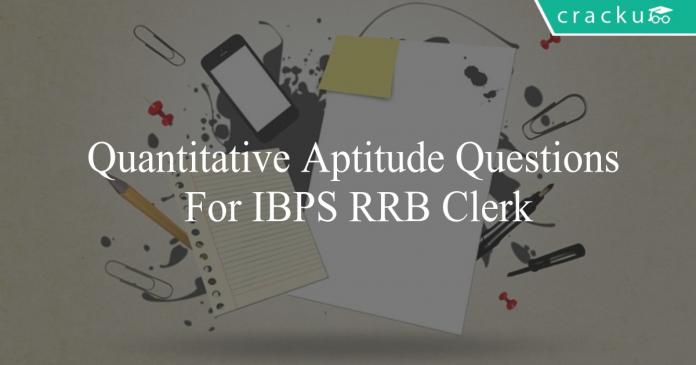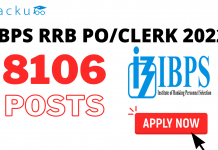Quantitative Aptitude Questions For IBPS RRB Clerk
Download Top-20 IBPS RRB Clerk Quantitative Aptitude Questions PDF. Quantitative Aptitude questions based on asked questions in previous year exam papers very important for the IBPS RRB Assistant exam.
Download Quantitative Aptitude Questions For IBPS RRB Clerk
35 IBPS RRB Clerk Mocks @ Rs. 149
70 IBPS RRB Mocks (PO + Clerk) for Rs. 199
Take a free mock test for IBPS RRB Clerk
Download IBPS RRB Clerk Previous Papers PDF
Question 1: Find the approximate value of $\Large\frac{169.87^{2}-13.94^{2}}{183.87}$ $\large+$ $\Large\frac{3211.96}{44.002}$
a) 224
b) 236
c) 239
d) 229
e) None of these
Question 2: Find the approximate value of $17.33+142.895-76.795+235.008-4.779+38.102$
a) 321
b) 351
c) 281
d) 371
e) None of these
Question 3: Find the approximate value of ‘x’ in $\Large\frac{383.96}{x} = \frac{x}{24.01}$
a) 84
b) 96
c) 92
d) 88
e) None of these
Question 4: Find the approximate value of $\sqrt{6560}\div2.98^{2}+\sqrt[3]{2189}\div\sqrt{2700}\times\sqrt{5180}\div\sqrt[3]{25}$
a) 11
b) 15
c) 20
d) 5
e) None of these
Question 5: Find the approximate value of $153.001\times146.95-66.009\times73.952+25.001\times23.856$
a) 17952
b) 18207
c) 18456
d) 17605
e) None of these
Question 6: Find the approximate value of $\small1798.98\div8.01\times51.965\div779.97-390.001\div25.87$
a) 5
b) 12
c) 0
d) 20
e) None of these
Question 7: Find the approximate value of $\small12.001+156.998-26.879+83.02-124.985$
a) 95
b) 110
c) 105
d) 84
e) None of these
Question 8: Find the approximate value of ‘x’ in $\Large\frac{107.89}{x} = \frac{x}{11.96}$
a) 30
b) 24
c) 36
d) 42
e) None of these
Question 9: Find the approximate value of $\sqrt[3]{10645}\div\sqrt{249}\times\sqrt{4084}\div\sqrt[3]{1328}\div\sqrt[6]{26}$
a) 6
b) 2
c) 12
d) 4
e) None of these
Free Mock Test for IBPS RRB PO
IBPS RRB Clerk Previous Papers
Question 10: Find the approximate value of $69.93$% $of$ $2098.98-149.89$% $of$ $537.789+19.97$% $of$ $1604.87$
a) $968$
b) $984$
c) $992$
d) $976$
e) None of these
Question 11: To meet the demand during summer, a milkman mixed water with pure milk in 2:5. Then he sold the same mixture at 20% more than normal price. By what percent his revenue will increase during summers? (Water is available without any cost)
a) 60 percent
b) 50 percent
c) 40 percent
d) 68 percent
e) 63 percent
Question 12: A retailer bought 5 dozen notebooks. He got these notebooks at 30% less than printed price. To clear his stock soon he offered 1 notebook free on buying 4 notebooks. If the retailer sold all notebooks on printed price, what’s is retailer’s profit percentage in this transaction?
a) 28.57%
b) 21.35%
c) 12.48%
d) 42.89%
e) 14.28%
Question 13: Krishna purchased a new laptop. After 2 years, he sold it to Pradeep at a discount of 30% when compared to the actual cost price. Pradeep spent 680 for repairing the laptop after purchase. After using it for 2 years, he sold it to Ravi at a discount of 30% when compared to the total amount he invested in the laptop. If Ravi paid exactly half the amount which Krishna paid, find the amount that Krishna paid when he purchased the laptop?
a) 47600
b) 36600
c) 68000
d) 72000
e) None of the above.
Question 14: Gugan sold a computer to Raj by marking the price up by 20%. Raj then sold the computer to Hari at a profit of 30%. Hari sold the computer to Balu at a profit of 50%. If Balu bought the computer by paying Rs. 1560 more than the price at which Hari bought the computer, what is the actual cost price of the computer?
a) Rs.1000
b) Rs.2000
c) Rs.3000
d) Rs.4000
e) Rs.5200
Question 15: A shopkeeper marks up the price of an article by x%. Then, he offers a discount of (x/2)%.If he ends up with a loss of 48%, then the value of x is
a) 120
b) 80
c) 140
d) 160
e) 60
Question 16: A shopkeeper buys pencils at the prize of Rs. 150 a dozen. Then, he marks up the price of each pencil by 20%. If he offers 2 consecutive discounts of 10%, what is his overall profit/loss percentage?
a) 1.25% profit
b) 1.2% profit
c) 1.4% profit
d) 1.4% loss
e) 2.8% loss
Question 17: A shopkeeper buys a dozen fruits for Rs. 3. At what price must he sell the fruits if he wants to realize a profit of 20 %?
a) 9 fruits for 30 rupees
b) 6 fruits for 15 rupees
c) 10 fruits for 6 rupees.
d) 90 fruits for 30 rupees
e) 50 fruits for 15 rupees
Question 18: Mukesh buys a pen at a certain price. He marks up the price of the pen by 30 percent. He then starts offering a discount of 20 percent. If Mukesh makes a profit of 16 rupees in the transaction then find the price at which he bought the pen.
a) 500
b) 600
c) 400
d) 800
e) 1000
Question 19: A shopkeeper buys some pins at 5 pins a rupee. How should he sell the pins if he wants to realize a profit of 50% ?
a) 20 pins for 5 rupees
b) 8 pins for 2 rupees
c) 12 pins for 4 rupees
d) 30 pins for 5 rupees
e) 10 pins for 3 rupees
Question 20: Mukesh buys a pen at a certain price. He marks up the price of the pen by 30 percent. He then starts offering a discount of 20 percent. If Mukesh makes a profit of 16 rupees in the transaction then find the price at which he bought the pen.
a) 500
b) 600
c) 400
d) 800
e) 1000
Quantitative Aptitude formulas PDF
520 Banking Mocks – Just Rs. 499
Answers & Solutions:
1) Answer (D)
$\Large\frac{169.87^{2}-13.94^{2}}{183.87}$ $\large+$ $\Large\frac{3211.96}{44.002}\simeq \frac{170^{2}-14^{2}}{184}$ $\large+$ $\Large\frac{3212}{44}$
$= \Large\frac{(170+14)(170-14)}{184}$ $+$ $73$
$= \Large\frac{184\times156}{184}$ $+$ $73$
$= 156+73 = 229$
2) Answer (B)
$17.33+142.895-76.795+235.008-4.779+38.102 \simeq 17+143-77+235-5+38$
Adding all positive terms:
$17+143+235+38 = 433$
Adding all negative terms:
$77+5 = 82$
$\therefore$ $17+143-77+235-5+38 = 433-82 = 351$
3) Answer (B)
$\Large\frac{383.96}{x} = \frac{x}{24.01}$
$\Rightarrow x^{2} \simeq 384\times24 = 9216$
$\therefore$ x $= \sqrt{9216} = 96$
4) Answer (B)
$\sqrt{6560}\div2.98^{2}+\sqrt[3]{2189}\div\sqrt{2700}\times\sqrt{5180}\div\sqrt[3]{25} \simeq \sqrt{6561}\div3^{2}+\sqrt[3]{2197}\div\sqrt{2704}\times\sqrt{5184}\div\sqrt[3]{27}$
$= \Large\frac{\sqrt{6561}}{3^{2}}+\frac{\sqrt[3]{2197}\times\sqrt{5184}}{\sqrt{2704}\times\sqrt[3]{27}}$
$= \Large\frac{81}{9}+\frac{13\times72}{52\times3}$ $= 9+6 = 15$
18000 Free Solved Questions – Banking Study Material
35 IBPS RRB Clerk Mocks @ Rs. 149
5) Answer (B)
$153.001\times146.95-66.009\times73.952+25.001\times23.856 \simeq 153\times147-66\times74+25\times24$
$153\times147$ can be written as $(150+3)(150-3)$
$=$ $150^{2}-3^{2}$ $(\because (a+b)(a-b) = a^{2}-b^{2})$
$=$ $22500-9$ $=$ $22491$
$66\times74$ can be written as $(70-4)(70+4)$ $=$ $70^{2}-4^{2}$ $=$ $4900-16 = 4884$
$25\times24$ can be written as $24\times\Large\frac{100}{4} =$ $600$
$\therefore$ $153\times147-66\times74+25\times24 = 22491-4884+600 = 18207$
6) Answer (C)
$1798.98\div8.01\times51.965\div779.97-390.001\div25.87 \simeq 1800\div8\times52\div780-390\div26$
$= \Large\frac{1800\times52}{8\times780}-\frac{390}{26}$
$= 15-15 = 0$
7) Answer (E)
$12.001+156.998-26.879+83.02-124.985 \simeq 12+157-27+83-125$
Adding all positive terms
$12+157+83 = 252$
Adding all negative terms
$27+125 = 152$
$\therefore 12+157-27+83-125 = 252-152 = 100$
8) Answer (C)
$\Large\frac{107.89}{x} = \frac{x}{11.96}$
$\approx$ $\Large\frac{108}{x} = \frac{x}{12}$
$\Rightarrow$ x$^{2} = 108\times12 = 1296$
$\therefore x = 36$
9) Answer (D)
$\large\sqrt[3]{10645}\div\sqrt{249}\times\sqrt{4084}\div\sqrt[3]{1328}\div\sqrt[6]{26} \simeq \sqrt[3]{10648}\div\sqrt{256}\times\sqrt{4096}\div\sqrt[3]{1331}\div\large\sqrt[6]{27}$
$\large\sqrt[6]{27}$ $=$ $(27)^{\large\frac{1}{6}}$ $=$ $(27^{\large\frac{1}{3}})^{\large\frac{1}{2}}$ $=$ $(3)^{\large\frac{1}{2}}$ $\simeq$ $(4)^{\large\frac{1}{2}}$ $= 2$
$\Large\frac{22\times64}{16\times11\times2} =$ $4$
10) Answer (B)
$69.93$% of $2098.98$ $\simeq$ $70$% of $2100$ $=$ $\Large\frac{70}{100}$ $\times$ $2100 = 1470$
$149.89$% of $537.789$ $\simeq$ $150$% of $538$ $=$ $\Large\frac{150}{100}$ $\times$ $538 = 807$
$19.97$% of $1604.87$ $\simeq$ $20$% of $1605$ $=$ $\Large\frac{20}{100}$ $\times$ $1605 = 321$
$\therefore$ $69.93$% of $2098.98-149.89$% of $537.789+24.97$% of $1604.87 = 1470-807+321 = 984$
11) Answer (D)
Let us assume that on a normal day he sells milk at x rupee per litre and he sells y litre of milk
So revenue generated on normal day = x*y = xy
He mixed water with milk in ratio of 2:5 so net quantity = $\frac{2+5}{5} * y$ = 1.4y
New selling price during summer = 1.2x rupees per litre
So revenue generated in summers = 1.4y * 1.2x = 1.68xy
Hence we can say that revenue will go up by 68 percent.
12) Answer (E)
Number of notebooks that retailer bought = 5 * 12 = 60
Let us assume that printed price on each notebook = 100
The retailer bought these notebooks at 30% less = 70 Rupees/notebook
Sum invested by the retailer = 60*70 = 4200
By selling 60 notebooks he will get money for = $\frac{4}{5}*60$ = 48 notebooks
Money collected by the retailer by selling these notebooks = 48*100 = 4800
Hence, retailer’s profit percentage = $\frac{4800-4200}{4200}*100$ = 14.28%
13) Answer (A)
Let assume Krishna paid 100x when he purchased the laptop.
So Krishna sold it to Pradeep for = $\frac{100-30}{100}*100x$ = 70x
And Pradeep also spent 680 rupees for repairing
So total amount invested by Pradeep = 70x+680
So the amount Ravi paid to Pradeep = $\frac{100-30}{100}*(70x+680)$ = 49x+476
We also know that Ravi paid exactly half of what Krishna paid
i.e. 0.5*(100x) = 49x+476
$\Rightarrow$ x = 476
So the amount for which Krishna purchased the laptop = 100*476 = 47600
14) Answer (B)
Let the worth of the computer to be Rs. x.
Let the price at which Raj bought the computer be 1.2x.
Price at which Hari bought = 1.3*1.2x = 1.56x
Price at which Balu bought = 1.5*1.56x = 2.34x
Difference between the prices at which Balu and Hari bought = 2.34x – 1.56x = 0.78x
It has been given that 0.78x = 1560
x = Rs. 2000.
Therefore, option B is the right answer.
15) Answer (D)
Let the price of the article be $P$.
Let us consider $x$ in decimal form for the ease of calculation.
$(1+x)(1-x/2)P = 0.52P$
$(1+x)(2-x) = 1.04$
$2-x+2x -x^2 = 1.04$
$-x^2+x = -0.96$
$x^2-x-0.96 = 0$
$x = 1.6$ or $x = -0.6$
We can ignore the negative root since it has been given that the shopkeeper marks up the price of the product.
=> $x = 160$% and hence, option D is the right answer.
16) Answer (E)
Cost of a pencil = Rs. 150/12 = Rs.12.5
Marked price = 1.2*12.5 = Rs. 15
The shopkeeper offers 2 consecutive discounts of 10%.
Therefore, the selling price of the pencil will be 0.9*0.9*15 = Rs. 12.15
Profit/loss percentage of the shopkeeper = (12.15 – 12.5)/12.5 = 2.8% loss.
Therefore, option E is the right answer.
17) Answer (E)
Cost price of a fruit = 3/12 = Rs. 0.25
Selling price = 1.2*0.25 = Rs.0.3
Let us check the options one by one.
9 fruits/ 30 rupees => Cost of 1 fruit = 30/9 = Rs.3.33
6 fruits/15 rupees => Cost of 1 fruit = 15/6 = Rs. 2.5
10 fruits/ 6 rupees => Cost of 1 fruit = 6/10 = Rs. 0.6
90 fruits/30 rupees => Cost of 1 fruit = 30/90 = Rs. 0.33
50 fruits/ 15 rupees => Cost of 1 fruit = 15/50 = Rs. 0.3
Therefore, option E is the right answer.
18) Answer (C)
Let the price at which he bought the pen be 100x.
He marks it at 130x and then sells it at 130x*.8 = 104x
Thus, he makes a profit of 4x.
We know that 4x = 16
=> x = 4
Hence, he bought the pen for 400.
19) Answer (E)
It has been given that the shopkeeper buys 5 pins a rupee.
Therefore, cost of a pin = 1/5 = 20 paise.
After marking up by 50%, the price of the pin will be 30 paise per pin.
20 pins for 5 rupees = 25 paise per pin
8 pins for 2 rupees = 25 paise per pin
12 pins for 4 rupees is 33.33 paise per pin
30 pins for 5 rupees is 60 paise per pin
10 pins for 3 rupees in 30 paise per pin
Therefore, option E is the right answer.
20) Answer (C)
Let the price at which he bought the pen be 100x.
He marks it at 130x and then sells it at 130x*.8 = 104x
Thus, he makes a profit of 4x.
We know that 4x = 16
=> x = 4
Hence, he bought the pen for 400.





